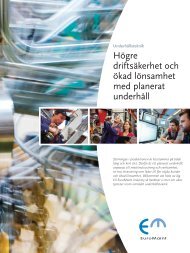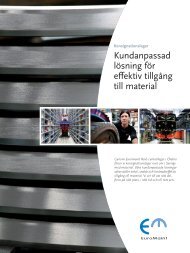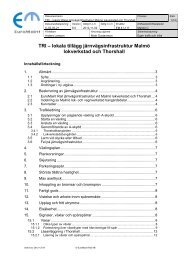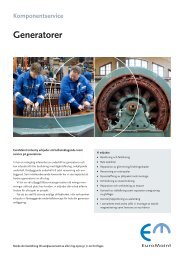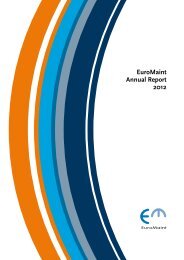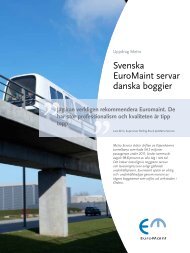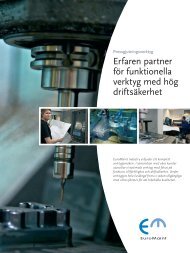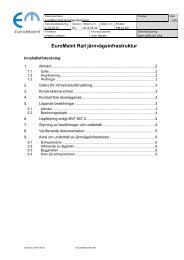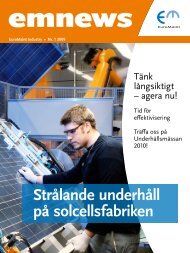Annual Report 2006 (pdf) - EuroMaint Rail
Annual Report 2006 (pdf) - EuroMaint Rail
Annual Report 2006 (pdf) - EuroMaint Rail
You also want an ePaper? Increase the reach of your titles
YUMPU automatically turns print PDFs into web optimized ePapers that Google loves.
E u r o M a i n t A n n u a l R e p o r t 2 0 0 6<br />
Notes<br />
Note 1<br />
Accounting principles Contd.<br />
Intra-Group transactions and balance sheet items, as well as profits<br />
on transactions between Group companies, are eliminated. Losses<br />
are also eliminated, unless the transaction is proof of a write-down<br />
requirement for the transferred asset. The accounting principles<br />
for subsidiaries have been changed where appropriate to guarantee<br />
consistent application of the Group’s principles.<br />
Business combinations<br />
IFRS 3 entails establishing the fair value of identifiable assets and<br />
liabilities in the acquired operation at the time of acquisition. Identifiable<br />
assets and liabilities also include assets, liabilities and provisions<br />
including obligations and demands from external parties not reported<br />
in the acquired operation’s balance sheet. No provisions are made<br />
for costs relating to planned restructuring measures resulting from<br />
the acquisition. The difference between the cost of the acquisition<br />
and the acquired proportion of net assets in the acquired operation is<br />
classified as goodwill and is recognised as an intangible asset in the<br />
balance sheet.<br />
The useful life of each individual intangible asset is established<br />
and the asset’s fair value is amortised over its useful life. If the useful<br />
life is deemed indefinite, no amortisation takes place. If the useful life<br />
of an intangible asset is deemed indefinite, all relevant conditions are<br />
taken into account and based on there being no foreseeable upper<br />
time limit for the net cash flow generated by the asset. The useful life<br />
for goodwill is generally assumed to be indefinite.<br />
Segment reporting<br />
As the subsidiaries conduct separate operations with separate products<br />
and services, their operations have been chosen as the primary<br />
segment. Sales between subsidiaries are based on market conditions.<br />
All assets and liabilities have been included for each subsidiary.<br />
Segment information per subsidiary is given in Note 3.<br />
Translation of foreign currencies<br />
Transactions in foreign currencies are translated at the rate used on<br />
the transaction date. Receivables and liabilities in foreign currencies<br />
are translated at the exchange rates in force on the balance sheet<br />
date. Exchange rate differences on loans and investments in foreign<br />
currencies are reported as financial revenues or financial expense.<br />
Other exchange differences are included in operating revenues.<br />
Tangible fixed assets<br />
Tangible fixed assets are recognised at cost less accumulated depreciation<br />
according to plan and accumulated write-downs. Depreciation<br />
takes place in accordance with a systematic plan over the useful life of<br />
the asset to an estimated residual value.<br />
Additional costs are added to the asset’s carrying amount or<br />
recognised as a separate asset, as appropriate, only when it is likely<br />
that future economic benefits associated with the asset will accrue to<br />
the Group and the asset’s cost can be measured in a reliable way. All<br />
other forms of repair and maintenance are recognised as expenses in<br />
the income statement for the period in which they arise.<br />
In order to distribute the cost of tangible fixed assets down to the<br />
estimated residual value, depreciation takes place linearly over the<br />
estimated useful life, in accordance with the following percentages.<br />
Machinery and equipment 10–20<br />
Computers and terminals 33<br />
Improvements to third-party property 10–20<br />
The residual values and useful lives of assets are tested on each<br />
balance sheet date and adjusted as necessary. An asset’s carrying<br />
amount is depreciated immediately to its recoverable amount (the<br />
higher of the net selling price and value in use) if the asset’s carrying<br />
amount exceeds its estimated recoverable amount.<br />
Profits and losses from sales are established by means of a<br />
comparison between the sales proceeds and carrying amount and the<br />
result is recognised in the income statement.<br />
Intangible assets<br />
Goodwill<br />
Goodwill is the amount by which the cost exceeds the fair value of the<br />
Group’s proportion of the subsidiary’s identifiable net assets upon<br />
acquisition. Goodwill is recognised as an intangible asset. Profit or<br />
loss from the sale of a unit includes the remaining carrying amount<br />
of the goodwill pertaining to the sold unit.<br />
Goodwill is distributed between cash generating units upon testing<br />
to determine any write-down requirement. The write-down requirement<br />
for goodwill is tested as follows: the goodwill value established at<br />
the time of acquisition is distributed among cash generating units or<br />
groups of cash generating units, which are expected to bring benefits<br />
through the acquisition in the form of synergy effects. Assets and<br />
liabilities already within the Group at the time of acquisition may<br />
also be attributed to these cash generating units. Each cash flow<br />
of this kind to which goodwill is distributed, corresponds to the<br />
lowest level in the Group at which goodwill is monitored in the<br />
company’s Board and is not a larger part of the Group than a<br />
segment. A write-down requirement exists when the recoverable<br />
amount for a cash generating unit, or group of cash generating units,<br />
is lower than the carrying amount. In such cases a write-down is<br />
entered in the income statement.<br />
Other intangible assets/Customer relations<br />
In connection with corporate acquisitions, the Group has identified<br />
intangible assets which fulfil the criteria set out in IAS 38. Linear<br />
amortisation is applied over the useful life of the asset, which is taken<br />
as 8 years.<br />
The carrying amounts of intangible assets are tested to determine<br />
any write-down requirement when events or changes in circumstances<br />
indicate that the value may not be recoverable.<br />
Investment property<br />
Investment property is recognised at fair value, which equates to<br />
the market value and is established annually by external and internal<br />
valuers. Changes in fair value are recognised in the income statement<br />
as part of the Other operating revenues item.<br />
The “Land and buildings” header in Note 7 mainly recognises<br />
rebuilding of hired premises and investment property.<br />
50



